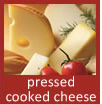The Large Wheel Family
The cheeses in this family fall into two distinct groupings: hard table or grating cheeses, and mountain-style cheeses, which have characteristic "eyes" or holes. Both groups include some of the world's most popular cheeses: Pecorino Romano and Parmigiano-Reggiano are both grating-style cheeses, and Emmental and Gruyère are characteristic of the mountain cheeses.
Making of Pressed Cooked Cheeses
Both styles of pressed cooked cheeses start from the same process: the curds are cut up into small pieces, placed in molds heated and then pressed to release excess moisture and solidify. Most pressed cooked cheeses have a rind that is thick and firm. The rinds vary in color from a pale ocher to a golden ocher to a shiny brown.
Making of Parmigiano-Reggiano - Grana Cheeses
After heating the small curd to 127°F in copper vats (which have a natural acidity that helps coagulation), the cheese, from skim milk, is placed into a mold and pressed to remove excess moisture. It is then rubbed with salted water to help create the unique tough rind found on these cheeses. After being brushed and turned daily for three weeks, the cheeses are transferred to a warm ripening room for maturation.
The cheeses in this family fall into two distinct groupings: hard table or grating cheeses, and mountain-style cheeses, which have characteristic "eyes" or holes. Both groups include some of the world's most popular cheeses: Pecorino Romano and Parmigiano-Reggiano are both grating-style cheeses, and Emmental and Gruyère are characteristic of the mountain cheeses.
Making of Pressed Cooked Cheeses
Both styles of pressed cooked cheeses start from the same process: the curds are cut up into small pieces, placed in molds heated and then pressed to release excess moisture and solidify. Most pressed cooked cheeses have a rind that is thick and firm. The rinds vary in color from a pale ocher to a golden ocher to a shiny brown.
Making of Parmigiano-Reggiano - Grana Cheeses
After heating the small curd to 127°F in copper vats (which have a natural acidity that helps coagulation), the cheese, from skim milk, is placed into a mold and pressed to remove excess moisture. It is then rubbed with salted water to help create the unique tough rind found on these cheeses. After being brushed and turned daily for three weeks, the cheeses are transferred to a warm ripening room for maturation.
Making Mountain-Style Cheeses
The clear mark of distinction is the holes or "eyes" which form during the initial stage of ripening, when carbon dioxide is emitted from the maturing curd. Once the wheels are produced, they are stored in curing rooms kept at 50°F to 55°F for anywhere from 4 months to a year or more. The cheesemaker checks the whole milk cheese by thumping to hear if the eyes have sufficiently formed.
Dominant Flavors
Hard/grating style cheeses, such as Grana Padano and Parmigiano-Reggiano, are known for their pronounced flavor and grainy textures. Mountain-style cheeses, such as Emmenthal, Gruyère and Comté, all have that distinctive robust and nutty flavor that has a broad appeal.
The clear mark of distinction is the holes or "eyes" which form during the initial stage of ripening, when carbon dioxide is emitted from the maturing curd. Once the wheels are produced, they are stored in curing rooms kept at 50°F to 55°F for anywhere from 4 months to a year or more. The cheesemaker checks the whole milk cheese by thumping to hear if the eyes have sufficiently formed.
Dominant Flavors
Hard/grating style cheeses, such as Grana Padano and Parmigiano-Reggiano, are known for their pronounced flavor and grainy textures. Mountain-style cheeses, such as Emmenthal, Gruyère and Comté, all have that distinctive robust and nutty flavor that has a broad appeal.

















